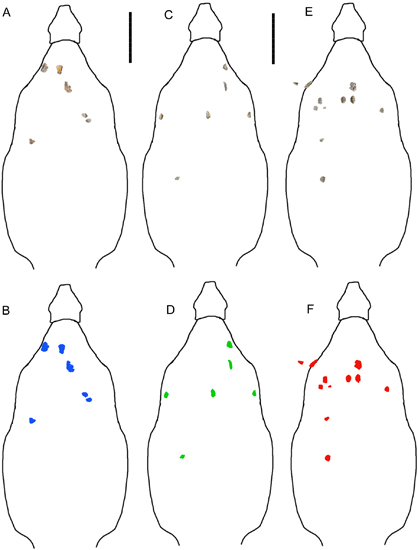A New Nodosaur from New Mexico
Invictarx zephyri
Scientists from the Western Science Centre, based in California, have announced the discovery of a new species of armoured dinosaur, a member of the Nodosauridae family of dinosaurs. The dinosaur is the first new species of dinosaur to be named from fossils found in the Menefee Formation of New Mexico.
This dinosaur fossil discovery suggests that nodosaurids persisted in western North America (Laramidia), throughout the Late Cretaceous, whereas, the closely related ankylosaurids died out in this part of the world as sea levels rose and only became established in Laramidia again millions of years later. The dinosaur has been named Invictarx zephyri.
A Life Reconstruction of the New Armoured Dinosaur Invictarx zephyri

Picture credit: Kara Kelley/Western Science Centre
Three Individual Armoured Dinosaur Specimens
A total of three individual dinosaurs were found, the first of which was discovered in 2011. All the specimens were collected from outcrops of the Juans Lake Beds, the upper part of the Allison Member of the Menefee Formation, located in San Juan County (New Mexico). A precise date for the strata at this locality is difficult to obtain but ammonite fossils found in the overlying marine sandstones suggest that I. zephyri lived some 80 million years ago.
All three specimens consist of highly fragmentary fossil material, although the shape of the osteoderms (dermal armour), along with the stratigraphical position of the fossil material (Lower Campanian aged strata from the Menefee Formation), enabled the researchers to erect a new genus. As well as the osteoderms, the fossils include rib fragments, a piece of the left humerus, a partial ulna, dorsal vertebrae, an incomplete toe bone and elements from the radii (arm bones).
Reconstruction of the Identifiable Osteoderm Elements in the Three Individual Dinosaurs (Invictarx zephyri)

Picture credit: PeerJ
The picture above shows the life position of the identifiable osteoderms associated with the three Invictarx specimens (A,C,E). The holotype specimen is labelled (A). The drawings below (B, D, F) provide a colour key. The body outline of Invictarx is not known, so the researchers have inferred the body shape (the illustration above is based on another nodosaurid Sauropelta edwardsorum).
Evidence of a Sacral Shield
Although the remains are far from complete, the researchers writing in the academic journal “PeerJ”, suggest that this dinosaur had a sacral shield (co-ossified pelvic shield), similar to the sacral shield of Polacanthus and Gastonia. Amongst the osteoderms, potential components of a bony shield were found. Several other dinosaur fossils from the Menefee Formation have been identified by the research team, including ornithischian and theropod remains, these are awaiting formal description, but more new dinosaur taxa are likely to be announced in the future.
Osteoderms of Invictarx (Specimen Number UMNH VP 28350)
Picture credit: PeerJ
The photograph (above) shows various views of some of the osteoderms associated with Invictarx. The red box (inset) shows two views of a large piece of armour that probably represents a portion of a broad, rounded plate, an indication that this dinosaur had a sacral shield.
Implications for Nodosaurids and Ankylosaurids in Western North America
Lots of different types of armoured dinosaur have been discovered in North America. Both nodosaurids and their club-tailed relatives the ankylosaurids are represented. However, the discovery of an 80-million-year-old nodosaurid in New Mexico, in conjunction with other recent armoured dinosaur finds suggests that whilst the nodosaurs were present in Laramidia during the Late Cretaceous, the related ankylosaurs were absent for several millions of years and only re-populated this part of North America towards the very of the Cretaceous period, most likely by migrating into Laramidia across an Asian land bridge.
The Discovery of the Nodosaur Invictarx zephyri Supports the Idea of Nodosaurids Persisting Whilst Ankylosaurs Suffered a Local Extinction

Picture credit: PeerJ with additional annotation by Everything Dinosaur
The researchers state that the loss of ankylosaurids from Laramidia coincides with the inundation of the Western Interior Seaway in the Cenomanian faunal stage of the Cretaceous, around 100 million years ago. Ankylosaurs did not re-populate Laramidia until the Campanian faunal stage around 80 million years ago.
To view models and replicas of armoured dinosaurs and other members of the Dinosauria: PNSO Age of Dinosaurs Models.
The Naming of Invictarx zephyri
The genus and trivial name for this new nodosaurid taxon were inspired by the dinosaur’s armour and the field team’s experience during their first excavation of the fossil material in 2011. The dig site was situated at the top of a high ridge that was blasted by strong winds. The name translates from the Latin as the “unconquerable fortress of the western wind”.
Visit the Everything Dinosaur website: Everything Dinosaur.


